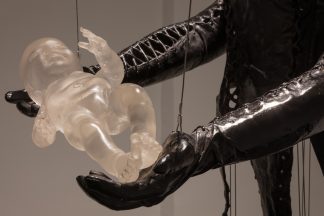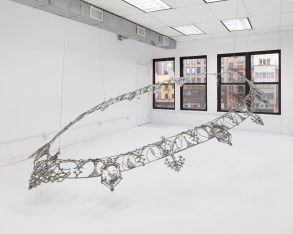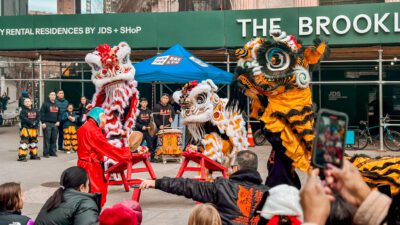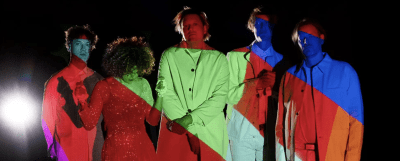Marsha Pels in her Greenpoint studio, courtesy of the artist
Sculptor Marsha Pels talks shop and remembers her friend Louise Bourgeois
Pels, who currently has two pieces on display at Lubov gallery, also recalls her life-changing friendship with artist Ana Mendieta
Personal and autobiographical objects assume universal significance in the work of Brooklyn-based sculptor Marsha Pels. The artist currently has two major works on display at Lubov gallery made 20 years apart: “Pieta” (1998) and “Fallout Necklace” (2018). You can see them through February 7 at Lubov gallery at 5 East Broadway, #402.
Here, in her own words, she discusses her work as well as her formative friendships with two women who influenced the future of sculpture in 1970s New York: French-American Louise Bourgeois, famed for her groundbreaking, monumental sculptures; and Cuban-born Ana Mendieta, conceptual performance and video artist, whose untimely death in 1985 was the subject of a controversial trial.
The following has been edited for flow and readability.

A detail of ‘Pieta,’ courtesy of Marsha Pels
Glass babies and lost wax
I make things, or I take found objects and transform them. “Pieta” is all cire perdue, lost wax [casting], and the cast elements in the necklace are sand-casted. It’s the two different main ways of casting. Everything in “Pieta” was transformed, everything including a plastic baby I bought at Toys-R-Us and cast it in glass. It’s a French doll, which is great because it looked so lifelike. All the gear was my S&M stuff I had collected. And the gas mask came from an army surplus store.
And then the elements in “Fallout Necklace” were not transformed from a found object but modeled after one I modeled those in Plasticine off of a 19th century image I’d seen of a cast iron Berlin necklace, and those were laid into the sand, pulled out, and then the metal is poured in. I’ve been doing both of those things since graduate school, in 1972, at Syracuse. That’s where I learned to cast. And both of those ways of casting have played out in different ways in my life.


‘Fallout Necklace,’ courtesy Marsha Pels
This gets really, you know … religious. I know I sound like such a metal-head now, but I am. If you ever experience that—I’m getting chills just thinking about it: When you’re standing there and you see this orange-hot metal that can kill you coming out, and you think of the Bronze Age, and you think of how long this has been going on, its alchemical, that’s what it is. And that real alchemical thing that happens with the material has to happen conceptually with the object.
The Dewar’s Fairy visits New York
I was living with my boyfriend from Brown, I’d gone to RISD. My first job after graduate school was welding in a foundry. I was the only woman working there, of course. I’d get home exhausted and so did he from construction work.
And he said “This is crazy. We’re in New York, we miss all the openings, we never meet any artists. We’re going to do the Dewar’s Fairy.”
I said, “What’s the Dewar’s Fairy?”
“Well, when I lost a tooth, my mother gave me some Dewar’s for the pain and take the tooth, put it under the pillow, and say, ‘Make a wish’.”
So we drank a bottle of Dewar’s and under each of our pillows [we wrote a name of the artist we wanted to meet on] a piece of paper. We promised to call them the next day. Under my pillow was Tom Doyle. And under his pillow was “Louise Bourgeois.” So I called Louise up and she said, “Come see me with your slides.”
So I went to see her. And we became very close during the 1970s. She’d take me to openings, we’d hang out, we’d steal things, and we’d go shopping and I adored her.
I’d meet her every Sunday at 6 a.m. in my pickup, I’d pick her up in Chelsea, and we’d go [to] this famous diner on the West Side Highway where there were taxi drivers, hookers, and artists, because [sculptor] John Chamberlain would go there really drunk with his pals at 3 a.m.
It was open 24 hours, so when we would get there at 6 a.m., everybody who was anybody was there, drunk from the night before. Edward Albee has a table, John Chamberlain has a table. Louise walks in and they all go, “Oh Louise, come, come.” And she goes, “No, no.” She’d order the same thing, she loved smoked salmon with a bagel and cream cheese, she put orange marmalade in her tea to sweeten it, and she had lemon meringue pie. Every time. Then we’d get up and she’d have a list: “There are these railroad ties in Hoboken I want to get, there are these granite parts of the street down there.” Oh! Almost all the doors for the “Cells,” I schlepped in my truck to her basement.
Nobody knew who she was then. I mean she was just teaching at Cooper Union. She wasn’t “the” Louise yet—it was Louise Nevelson. But I knew she was the most important sculptor in the world. Louise was working in the grand Modernist tradition. And I feel that I am in that tradition, but I’m trying to go into the 21st century.
The galvanizing death of a friend
I kind of came out of the closet as a feminist in the late 1980s. [My work] was lyrical and more about nature. The thing that changed me, to be honest with you, was the death of my friend Ana Mendieta.
Ana and I were good friends. She won a Prix de Rome the year before me in 1983 and I inherited her studio. So we became very close and I was waiting for her the day that she died.
I was part of the trial. I was a witness on her behalf. I don’t want to mention names, but that changed my life. The politicization, the way the art world split, to support her husband, Carl Andre, who many people accused of pushing her to her death, or to support and defend her against their demonization. That changed my whole perspective, and yeah, that’s what politicized me.
And that’s when I did “Acheron,” that big piece at Grounds for Sculpture, which has bodies in the boat. This sculpture was made for Ana. That’s her in the boat. I came home in 1985 in August, she died in September, and I started to make this sculpture. It was the first of my many boat pieces, but this one was about her ghost haunting me.
Those are my girls, Ana and Louise.
You might also like 


























